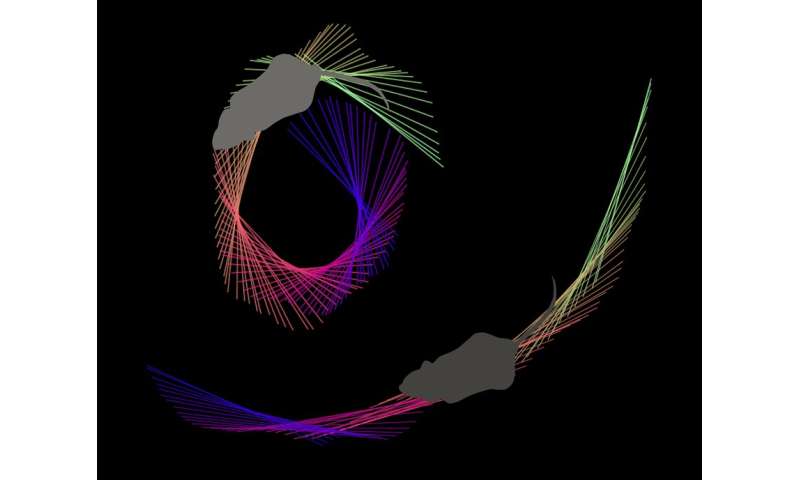
Researchers at University of Copenhagen and Karolinska Institute have recently carried out a study investigating the neural underpinnings of a specific locomotor ability in animals, which involves sideways movements (i.e., moving left or right). Their paper, published in Nature Neuroscience, highlights the vital role of a specific neuron population in the brainstem, the so-called Chx10 neurons, in allowing mice and potentially other animals with limbs to turn left or right while moving.
“Locomotion is a natural behavior universal to the animal kingdom,” Professor Ole Kiehn, senior researcher on the study, told MedicalXpress. “In vertebrates, coordination of rhythmic locomotor movements occurs largely within circuits of the spinal cord itself. For these circuits to function, they need commands from brain effector neurons.”
Past studies have found that brain effector neurons control a number of aspects of animal locomotion, including most mammals’ ability to start moving, speed up and stop. The neural mechanisms underlying sideways movements (i.e., left or right turns) in animals, however, have been studied less and are thus still poorly understood.
The ability to move in a particular direction is essential for almost every behavior, including foraging, navigation and escape,” Kiehn said.
In their previous work, Kiehn and his colleagues found that when symmetrically activated, a particular class of neurons, namely brainstem neurons that express the protein Chx10, can cause an animal to stop moving. When they started working on this new study, they hypothesized that when activated only on one side, these neurons could act as a turning pathway, allowing animals to turn left or right.
To test this hypothesis, the researchers genetically traced Chx10 neurons in the brain of mice. This allowed them to demonstrate a unilateral projection of these cells from the brainstem to the animal’s spinal cord.
“To show that Chx10 cells control asymmetric movements in vivo in mammals, we used a number of approaches where we can manipulate nerve cell activity up or down using either light-sensitive channels (optogenetic) or drug-activated artificial receptors (chemogenetic) that are expressed selectively in brainstem Chx10 cells,” Dr. Jared Cregg first author of the paper, told MedicalXpress. “This allowed us to manipulate the activity of these cells without affecting other nerve cells and directly relate their activity to the animals’ motor behavior.”
In their study, Kiehn and colleagues also investigated the effects of stimulating brainstem Chx10 cells in isolated brainstem spinal cord preparations. Interestingly, they found that Chx10 cells inhibit (i.e., break) the limb-locomotor networks, while simultaneously activating motor networks that control the animal’s trunk musculature on the same side of its body.
Finally, the researchers used deep-learning techniques to track limb and body movements while the mice were turning. The results of their analyses strongly suggest that brainstem Chx10 neurons allow mice to move left or right, coordinating their movements with shorter step lengths and bending of their trunk musculature on the side in which they are turning.
“We have identified a missing piece of the central control of locomotion in limbed animals: the ability to turn left and right,” Cregg said. “Our study strongly indicates Chx10 Gi neurons act as the final common effector for controlling left/right movements, opening a window into how different brain areas work in concert to control left or right decisions depending on diverse behavioral needs.”
The study offers evidence of a descending motor system that controls left and right movements in mammals. This is a highly valuable contribution to the field of neuroscience, as it could shed light on the neural underpinnings of motor disorders associated with a number of neurological diseases.
Source: Read Full Article